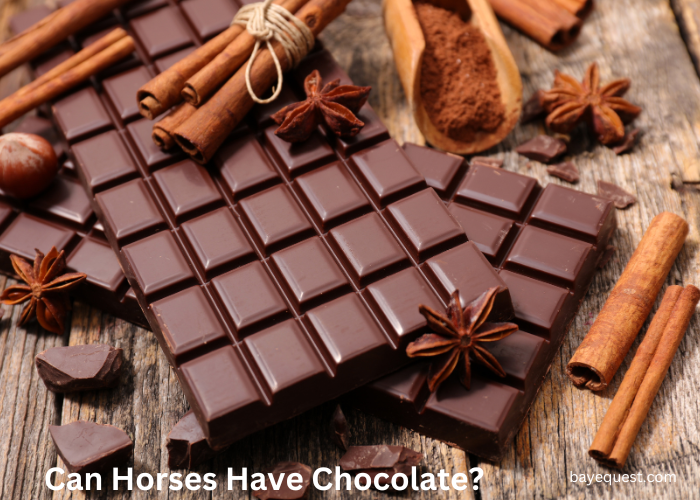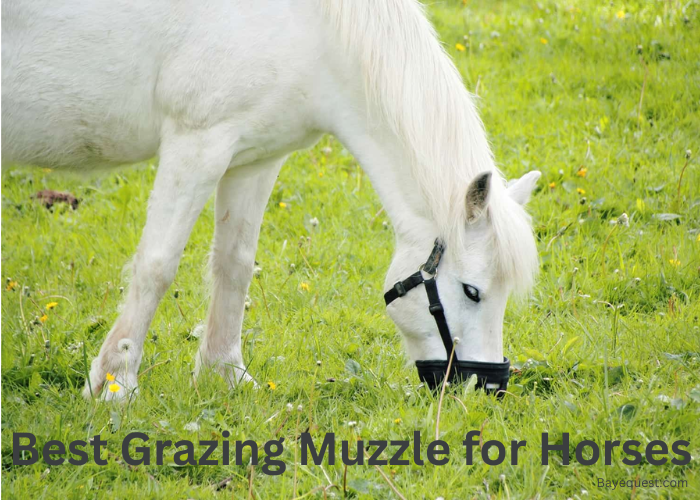Chocolate might be your favorite treat, but what about horses? Can these majestic animals enjoy the same sweet indulgence we do?
It’s a tempting thought—sharing a piece of your favorite snack with your four-legged friend. But before you unwrap that bar, there’s a lot you should know.
While some foods are safe for humans and animals alike, others can be dangerous. Let’s dig into whether chocolate is a safe treat or a harmful hazard for your horse.
It’s time to clear up the confusion once and for all.
Can Horses Have Chocolate? Key Takeaway
No, horses should not have chocolate. Chocolate contains theobromine, which is toxic to horses and can cause symptoms like seizures, increased heart rate, internal bleeding, restlessness, and muscle tremors. Feeding chocolate to horses can lead to serious health issues, making it unsafe for them to consume even small amounts.
Why is Chocolate Bad for Your Horses?
Chocolate is harmful to horses because it contains theobromine. Theobromine is a chemical that horses cannot break down well.
When horses eat chocolate, it can build up in their system. This can lead to serious health issues.
Symptoms include rapid heart rate, restlessness, and muscle tremors. In large amounts, it may cause seizures or even internal bleeding.
To keep your horse safe, never give them chocolate.
The Composition of Chocolate
Chocolate’s main ingredients are pretty straightforward: cocoa, sugar, and often milk. But the real concern for horses lies in a component called theobromine. This is a natural compound found in cocoa.
Here’s the breakdown:
Cocoa. This is where theobromine comes from. It gives chocolate its unique flavor and a bit of a kick.
Theobromine. Unlike humans, horses can’t process this compound effectively. It builds up in their system and can lead to poisoning.
Sugar. While not toxic, too much sugar can lead to other health issues for horses, like weight gain and dental problems.
Milk. Often added for creaminess, milk isn’t harmful, but it’s not a natural part of a horse’s diet.
Health Risks of Feeding Your Horse Chocolate
Feeding chocolate to horses poses significant health risks due to its theobromine content. Here are some health complications that can arise from a horse consuming chocolate:
Theobromine poisoning. Chocolate contains theobromine, a substance horses can’t process well. It builds up in their system, leading to symptoms like restlessness and excessive sweating. In serious cases, it might cause muscle twitching.
Heart problems. The theobromine in chocolate speeds up a horse’s heart rate. This can be dangerous, leading to irregular heartbeats and potentially heart failure if the dose is high enough.
Digestive issues. Chocolate can upset a horse’s stomach. It might cause diarrhea or, worse, colic—a severe abdominal pain that can be dangerous in horses.
Neurological effects. If a horse eats a lot of chocolate, the high levels of theobromine can affect its nervous system, leading to seizures or uncontrollable muscle tremors.
Liver stress. Over time, dealing with theobromine can strain a horse’s liver, leading to damage. The liver tries to break down the toxin, but it’s a tough job and can wear the organ out.
Obesity and diabetes risk. Chocolate is high in sugar and fat, which isn’t good for horses. Too much can lead to weight gain and increase the risk of diabetes, which complicates their health further.
Types of Chocolate and Their Theobromine Amounts
Below is a table detailing various types of chocolate and their typical theobromine content.
| Type of Chocolate | Theobromine Content (per 100g) |
| Dark chocolate | 1300-2500 mg |
| Milk chocolate | 150-250 mg |
| White chocolate | Minimal to none |
| Semi-sweet chocolate | 400-500 mg |
| Bittersweet chocolate | 450-1600 mg |
| Unsweetened chocolate | 2300-2500 mg |
| Ruby chocolate | 260-320 mg |
| Couverture chocolate | Varies, generally similar to dark chocolate |
| Gianduja chocolate | Depends on the ratio of chocolate to hazelnut paste, generally lower than pure dark chocolate |
What to Do When Your Horse Eats Chocolate
If your horse accidentally eats chocolate, act quickly to minimize the risk of serious health issues. Here’s what you should do:
Assess the amount. Determine how much chocolate your horse consumed and what type it was. Dark chocolate and unsweetened baking chocolate are more dangerous due to higher theobromine levels.
Call your veterinarian. Immediately contact your veterinarian or an emergency vet clinic. Inform them about the situation, including the type and amount of chocolate ingested. They can provide specific advice and may need to see your horse immediately.
Observe your horse. While waiting for the vet, keep a close eye on your horse for any signs of distress, such as restlessness, heavy breathing, diarrhea, or signs of colic. Note these symptoms to report to your vet, as they can help determine the severity of the poisoning.
Follow veterinary advice. Your vet may instruct you to bring your horse in for treatment or provide specific care instructions at home. Treatments might include administering activated charcoal to absorb the toxins or giving medications.
Hydrate. Ensure your horse can access plenty of fresh water to help flush out their system. This can aid recovery, although it should be done under veterinary guidance.
Prevent future incidents. After addressing the immediate crisis, take steps to prevent future accidents. Store all chocolate and other harmful foods out of reach of your horses. Also, educate everyone interacting with your horse about the dangers of feeding inappropriate treats.
Signs of Chocolate Toxicity in Horses
Chocolate toxicity in horses can present several symptoms that vary in severity depending on the amount and type of chocolate ingested. Here are the key signs to watch for:
a. Gastrointestinal distress. Look for signs of abdominal pain, such as pawing at the ground, looking at their flank, rolling, or other signs of discomfort. Diarrhea may also occur as the body tries to expel the toxin.
b. Increased heart rate. An elevated heart rate is an early sign of chocolate toxicity. The horse’s pulse may become rapid and weak as a response to theobromine.
c. Restlessness and hyperactivity. The horse might appear unusually restless or agitated. This can escalate to hyperactive behavior as the level of theobromine increases in their system.
d. Muscle tremors. As the toxicity progresses, muscle tremors may develop. These can be localized to certain muscle groups or generalized across the body.
e. Seizures. In severe cases, the horse may experience seizures. This is a critical symptom and requires immediate veterinary intervention.
f. Respiratory distress. Difficulty breathing or rapid breathing may occur if the toxicity affects the horse’s respiratory system.
g. Weakness and collapse. In extreme cases, especially if a large amount of chocolate is consumed, the horse may show signs of weakness or collapse.
How to Stop Horses from Eating Chocolates
Preventing horses from eating chocolate involves careful management and awareness, especially since even small amounts can be harmful. Here are some strategies to ensure your horse stays away from chocolate:
Educate everyone. Ensure everyone interacting with your horse knows that feeding horses chocolate is dangerous. Education is key to preventing accidental feeding.
Secure storage. Store chocolate and other non-horse foods securely. Use cabinets or containers that cannot be accessed by horses or by curious individuals who might not know the rules about feeding horses.
Safe treat alternatives. Provide safe and healthy treat alternatives that are suitable for horses. This can satisfy the desire to give treats without risking your horse’s health. Apples, carrots, and commercial horse treats are good options.
Signage. Putting up signs at the barn or feeding area listing safe and unsafe foods for horses can be a constant reminder for everyone.
Supervised interaction. Supervise interactions between your horse and visitors, especially if they’re unfamiliar with horses. This helps prevent them from feeding inappropriate items out of ignorance.
Regular checks. Regularly check the areas where your horse roams for discarded food items or trash containing chocolate or other harmful substances.
Behavioral training. Train your horse to only accept treats from specific containers or directly from you. This can help control their consumption.
Safe Alternatives to Chocolate for Horses
Offering your horse safe and suitable treats is a great way to bond and provide enrichment without the risks associated with chocolate. Here are some healthy and horse-friendly alternatives:
- Carrots
- Apples
- Hay Cubes
- Sugar-Free Peppermints
- Commercial Horse Treats
- Bananas
- Watermelon
- Oats
- Beet Pulp
- Pumpkin
- Celery (Read also: Benefits of Celery for Horses.)
- Letucce
- Broccoli
- Zucchini
- Cucumber
- Grapes
The Dietary Needs of Horses
Horses have specific dietary needs that are crucial for their health and well-being. Understanding these needs can help you maintain your horse in top condition.
Here are the key components of a horse’s diet and why they are important:
Forage
Forage, including hay and grass, should be the foundation of a horse’s diet. It’s essential for proper digestive function and provides the bulk of their calorie intake.
Horses are grazing animals, so continuous access to forage helps keep their digestive systems running smoothly and prevents issues like ulcers and colic.
Concentrates
Grains and commercial feeds provide additional calories and nutrients that might not be sufficiently available in forage. Horses with higher energy requirements, such as those in intense training or breeding mares need more calories.
You, therefore, need to balance the amount and type of concentrates to avoid overfeeding.
Vitamins and minerals
Horses need a variety of vitamins and minerals for overall health, including bone development, nerve function, and muscle health. Many horses can get the majority of these nutrients from a well-balanced forage-based diet.
Supplements might be necessary if the natural diet lacks certain elements or if the horse has specific health conditions.
Water
Always ensure that horses have access to fresh, clean water. In hot weather or when exercised heavily, horses can drink 5 to 10 gallons of water daily.
Water is vital for digestion and overall metabolic function.
Read also: How long can horses go without water?
Salt and electrolytes
Horses need salt in their diet, and an equine salt block can allow them to regulate their intake as needed. During hot weather or periods of heavy exercise, horses also lose electrolytes through sweat, which may need to be replenished with supplements.
Special dietary considerations
Certain horses may have specific needs due to age, health conditions, work level, or reproductive status.
For example, senior horses may need diets that are easier to digest and lower in calories but higher in vitamins and minerals. Performance horses might require more energy-dense foods.
Interesting read: Can Horses Eat Cabbage?
FAQs
Can horses eat chocolate mixed with oatmeal?
No, horses should not eat chocolate, even if it is mixed with oatmeal. Chocolate contains theobromine, which is toxic to horses. Adding oatmeal does not mitigate the risks associated with theobromine.
Is there a safe form of chocolate for horses?
No, there is no safe form of chocolate for horses. All types of chocolate contain theobromine to varying degrees, which harms horses.
Can horses eat blueberries?
Yes, horses can eat blueberries. They are a safe and healthy treat in moderation. Blueberries are rich in antioxidants and vitamins, making them a beneficial addition to a horse’s diet.
Can Horses Eat Chocolate? Conclusion
So, chocolate and horses? It’s a no-go. While sharing a sweet treat with your horse might be tempting, chocolate is off the menu.
Instead, stick to safe, horse-approved snacks like apples, carrots, or commercial horse treats. These will keep your horse happy and healthy without the risks that come with theobromine in chocolate.
Remember, the best treat for your horse is made just for them. So, next time you’re enjoying a chocolate bar, give your horse something they can enjoy safely. They’ll thank you for it.








